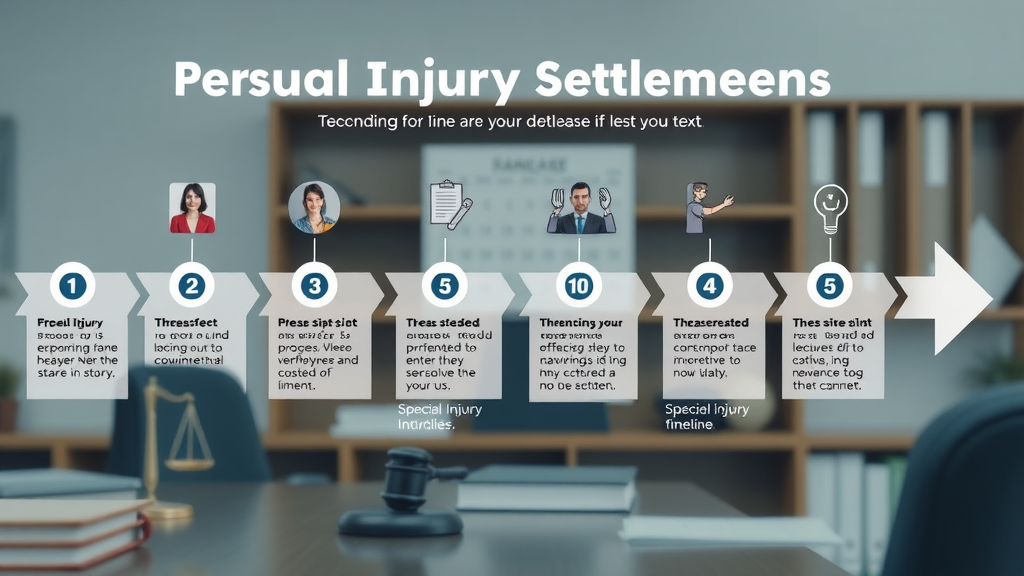Are you wondering how long it really takes to receive compensation after a personal injury? The answer might surprise you—while some injury cases settle in a matter of weeks, others can stretch out for years, depending on a range of factors. If you or a loved one is dealing with a personal injury claim , understanding the timeline and process can help you make confident decisions, avoid common pitfalls, and ultimately secure the best possible settlement . This guide offers deep insight into each phase, practical tips from experienced injury lawyers , and crucial information to keep your injury settlement process running smoothly.
Curious About How the Personal Injury Settlement Process Timeline Really Works?
- What you will learn about the personal injury settlement process timeline:
- • Key stages in the personal injury settlement process timeline
- • Common timeframes for personal injury cases and claims
- • Factors that influence your personal injury settlement timeline
- • Practical tips to avoid unnecessary delays

Overview of the Personal Injury Settlement Process Timeline
Understanding the Timeline of a Personal Injury Case
The personal injury settlement process timeline begins the moment you suffer harm due to someone else’s actions—whether it’s a car accident , slip and fall, or workplace incident. Typically, this process involves multiple stages designed to ensure that victims receive fair compensation for their losses. Understanding this timeline helps you set realistic expectations and prepare accordingly. Each phase—from seeking immediate medical treatment to negotiating with the insurance company —has specific timeframes and hurdles.
While all injury cases are different, many follow a similar structure. The journey through consultation, evidence gathering, negotiations, and possibly even litigation can range from a few months to several years based on the complexity of your injury claim and responsiveness of involved parties. Familiarizing yourself with these steps not only alleviates anxiety but also empowers you to be proactive throughout your settlement process.
What makes each personal injury case unique are variables like the extent of injuries, insurance company tactics, involvement of multiple parties, and the clarity of fault and damages. Mastering the timeline of a personal injury case enables you to work more effectively with your lawyer, collect crucial evidence, and avoid unnecessary delays.
Typical Steps in the Personal Injury Settlement Process
The typical personal injury settlement process timeline comprises several phases. It begins with an initial case evaluation by an injury lawyer , followed by evidence collection. This often includes police reports, medical records, and photos of the accident scene. Afterward, your lawyer will communicate with the insurance company, submit the claim, and attempt to negotiate a settlement. If negotiations break down, your lawyer may advise you to file a lawsuit; from there, the litigation phase involves discovery, court hearings, and potentially a trial.
It’s important to note that not all personal injury claims go to court. In fact, most are resolved through negotiations when clear liability and sufficient evidence exist. The duration of each step depends on factors such as your medical treatment, cooperation from other parties, and whether the case is settled or litigated. Throughout the settlement process, your lawyer’s negotiation skills and documentation are invaluable for achieving a fair result.
Below is a table showing the average duration for each phase:
| Stage | Estimated Duration | Key Actions |
|---|---|---|
| Consultation & Investigation | 1-4 Weeks | Contacting an injury lawyer, initial review of the injury claim and evidence |
| Medical Treatment & Maximum Medical Improvement (MMI) | Several Weeks to 1+ Years | Receiving medical treatment; waiting until maximum medical improvement |
| Gathering Records & Filing Claim | 1-2 Months | Collecting medical records, police reports, witness statements |
| Negotiation & Settlement Talks | Weeks to Months | Exchanging settlement offers with the insurance company |
| Litigation (if necessary) | 1-2+ Years | Filing a lawsuit, discovery, trial preparation, trial |
| Payout | Weeks after settlement/trial | Disbursement of funds to injury victim |
Key Phases in a Personal Injury Settlement Process Timeline
Initial Consultation and Investigation of Your Injury Claim
The start of the settlement process is often marked by a thorough initial consultation with a personal injury lawyer . During this meeting, the lawyer will gather all the facts of your personal injury case , including details about the accident, injuries suffered, and any steps you’ve already taken—such as seeking medical treatment or speaking with insurance representatives. This is when vital evidence, like photos from a car accident or eyewitness accounts, is identified and preserved.
After your consultation, the legal team launches their own investigation. This might involve inspecting the scene, obtaining surveillance footage, interviewing witnesses, and securing expert opinions to bolster your injury claim . Thorough investigation helps establish liability and ensures your personal injury claim reflects the true severity of your damages. Early action in this phase sets the foundation for the rest of your injury settlement process .

Medical Treatment and Documentation in the Personal Injury Lawsuit
Receiving proper medical treatment not only aids your recovery but also serves as vital documentation for your personal injury case . Injury law prioritizes immediate medical attention, and ongoing treatment records are used to demonstrate the impact of the incident on your life. If you fail to seek prompt medical care , insurance adjusters and opposing attorneys may argue that your injuries are not as serious as claimed.
Your medical records, doctor’s notes, bills, and photographs of your injuries become critical evidence for your injury lawyer when negotiating with the insurance company . These documents illustrate your suffering, the extent of physical and emotional damages, and how your injuries affect your daily activities. Once you reach maximum medical improvement (your recovery plateau), your lawyer will use this information to calculate the fair value of your injury settlement .
Determining Damages and Calculating Your Personal Injury Settlement
Calculating appropriate compensation is a critical component of the personal injury settlement process timeline . Your personal injury lawyer will evaluate both economic damages—such as lost wages, medical bills, and out-of-pocket expenses—and non-economic damages, like pain and suffering or loss of enjoyment of life. These calculations are supported by your medical records , employment documentation, and expert testimony.
For many victims, understanding how damages are determined can feel overwhelming. A seasoned injury attorney will use structured methodologies to assign value to your injuries and present these findings to the insurance company or, in court, as part of your personal injury lawsuit . The more thoroughly your legal team documents your losses, the greater your chance of achieving a fair settlement .

Filing Your Personal Injury Claim and Gathering Evidence
The Importance of Timely Filing Under Personal Injury Laws and Injury Law
Timeliness is crucial when initiating a personal injury claim . Each state enforces a statute of limitations—deadlines by which an injury lawsuit must be filed or the right to pursue compensation is lost forever. Filing your claim promptly ensures compliance with personal injury laws and preserves vital evidence that might otherwise fade or be lost. Delaying your claim could mean losing critical documents, witness recollections, or your eligibility under state law.
Your best defense against missing deadlines is strategic guidance from an experienced injury lawyer . Legal professionals are well-versed in local statutes and can track all relevant timelines for your unique injury case . Early filing allows for a more thorough investigation and increases the chances of a favorable outcome.
Gathering Medical Records, Police Reports, and Other Evidence After a Car Accident or Injury
For your personal injury lawsuit , collecting robust evidence is the key to proving liability and damages. This evidence includes medical records , police accident reports, photographs, witness statements, and documentation of your injuries and property damage. If your case involves a car accident , insurance adjusters often require detailed accident reports and statements from responding officers. The more documentation you provide, the stronger and more credible your injury claim becomes.
Collaborating with your legal team to compile and organize all documents can prevent delays during the settlement process. Promptly providing any new information about your treatment or changes in your condition also ensures that your injury lawyer can present the full scope of your claim when negotiating with the insurance company or in court.
"The strength of your personal injury claim is often determined by the thoroughness of your evidence." — Injury Attorney

Negotiations with the Insurance Company: How the Settlement Process Unfolds
Roles of the Injury Lawyer and Insurance Company in Personal Injury Claims
Negotiations are at the heart of the personal injury settlement process timeline . Here, your injury lawyer assumes the role of advocate, leveraging evidence and documentation to demand fair compensation from the insurance company . Adjusters for the insurance firm, in turn, work to protect their bottom line, often challenging the extent of injuries or the necessity of certain treatments. The two sides exchange offers and counteroffers until a settlement is reached or a lawsuit is filed.
The process can become contentious, especially if there is a dispute about liability or damages. Your attorney’s negotiation skills, knowledge of injury law , and understanding of fair settlement values play a crucial part in standing up to insurance company tactics. Effective communication and timely responses keep negotiations on track and move your claim closer to resolution.
What Makes a Fair Settlement Offer in the Personal Injury Settlement Process Timeline?
A fair settlement compensates for all losses suffered as a result of your personal injury . This means accounting for both tangible financial costs and intangible impacts, such as pain, emotional trauma, and loss of quality of life. A just offer should be supported by clear evidence and should reflect all medical expenses, ongoing care needs, lost earnings, and emotional suffering documented throughout the claim process.
Critical considerations when negotiating your injury settlement:
- • Assessment of damages (economic and non-economic)
- • Attorney negotiation strategies
- • Communication timelines and response deadlines
Patience and preparation are vital—accepting an initial low-ball offer may expedite a settlement, but could leave you with insufficient funds for future medical needs or unforeseen complications.

When Personal Injury Cases Go to Court: Personal Injury Lawsuit Timelines
From Filing to Trial: Key Milestones in a Personal Injury Lawsuit
If negotiations stall or fault is denied, your lawyer may recommend suing the responsible party. The injury lawsuit phase includes several key milestones: filing and serving the complaint, the discovery process (where evidence is exchanged), pre-trial motions, mediation attempts, and finally, the trial itself. Each of these stages can stretch out the personal injury settlement process timeline by months or even years, depending on the complexity of the case and court docket congestion.
Plaintiffs and defendants both submit evidence and testimony during discovery, often requiring depositions from medical experts and accident reconstruction specialists. At any point before the trial’s end, the parties can still reach a settlement . If not, the case culminates with a judge or jury rendering a verdict and, if successful, awarding compensation to the injury victim.

The Impact of Litigation on the Personal Injury Settlement Process Timeline
Choosing to file a lawsuit inevitably adds months, sometimes years, to the process. Motions may be filed, hearings rescheduled, and both sides will engage in lengthy evidence gathering and depositions. However, litigation may be necessary to force the insurance company to fairly value your injury claim or to resolve disputes about fault and damages. For many, the threat of trial can motivate a more reasonable settlement offer as the court date approaches.
Though the timeline stretches, successful litigation can result in higher compensation if the facts are on your side. Skillful navigation by an experienced personal injury lawyer helps streamline litigation where possible and keeps your case progressing efficiently.
Factors That Affect the Personal Injury Settlement Process Timeline
Complexities in Personal Injury Law, Injury Laws and Personal Injury Cases
Every personal injury case is unique, and complexities can arise from legal ambiguities, disputes over liability, or the involvement of multiple parties. Local and state personal injury laws may have complex requirements for filing, evidence disclosure, and settlement eligibility. When new facts emerge or experts must be consulted, the process can slow down.
Further complications, such as incomplete evidence or disputes about how injuries occurred, may trigger additional investigations or even independent evaluations. Working with a team well-versed in injury law and seasoned in managing complex claims helps keep your timeline moving, even when legal barriers arise.
Medical Treatment Duration, Recovery Times, and Expert Testimony
The duration of your recovery can dramatically influence how long your personal injury settlement process timeline will last. Courts and insurance companies prefer to settle only after you’ve reached maximum medical improvement . This ensures all damages, both immediate and long-term, are fully accounted for. For injuries requiring extended rehabilitation or surgeries, resolution may be delayed to avoid undervaluing your claim.
Doctors, specialists, and even life-care planners may be consulted to testify about the extent of your injuries and expected recovery. Their input plays a substantial role in determining compensation and can also affect how quickly your lawyer is able to present a clear and compelling case. Prompt and consistent medical care remains the best way to prevent unnecessary holdups.

Role of Injury Lawyers and Insurance Company Delays
Delays in the settlement process often stem from back-and-forth communication with the insurance company as they review documentation and assess liability. An experienced injury lawyer anticipates these tactics and works proactively to maintain steady pressure. Clear, concise documentation and prompt responses minimize opportunities for adjusters to stall or request additional information that drags out the process.
The expertise and workload of your legal team, as well as their negotiation strategies, can also influence the overall timeline. Lawyers with heavy caseloads or limited resources may inadvertently slow progress, while proactive, communicative attorneys push aggressively for timely settlements. Select your personal injury lawyer with care to ensure your case receives the attention it deserves.
Payouts and Settlements: What to Expect in Your Personal Injury Settlement
What is the Average Payout for a Personal Injury Settlement?
The average payout for a personal injury settlement varies widely based on the facts of each case. Minor accidents often result in settlements from $3,000 to $15,000, while severe or catastrophic injuries, especially those involving permanent disability, can yield six-figure awards or more. Factors such as lost wages, cost of future medical care, and emotional suffering are weighed alongside liability in determining final amounts.
Insurance companies take their cues from both precedents set by similar injury cases and from the documented damages you provide. Negotiating with the insurance company directly, especially without legal representation, often results in lower offers. Injury lawyers are skilled at maximizing these numbers through professional valuation and aggressive advocacy.
How Is the Injury Settlement Amount Determined?
Settlement amounts are determined by adding together economic damages—medical bills, lost income, and related costs—and non-economic damages like pain and suffering. Additional factors can include the likelihood of ongoing treatment, degree of permanent impairment, and even how compelling your evidence is. During negotiations or litigation, both your lawyer and the opposing insurance company will present their own calculations, supported by evidence and expert testimony.
| Case Type | Average Settlement Range |
|---|---|
| Minor Car Accident Injury | $3,000 – $15,000 |
| Moderate Car Accident or Slip & Fall | $20,000 – $75,000 |
| Severe Injury (Permanent/Disabling) | $80,000 – $250,000+ |
| Catastrophic Injury | $250,000 – $1,000,000+ |
"Every personal injury case is unique, and so is the settlement timeline." — Personal Injury Lawyer
People Also Ask: Common Questions About the Personal Injury Settlement Process Timeline
How long do most personal injury cases take to settle?
- Answer: Most personal injury settlement process timelines range from several months to a few years, depending on the complexity, degree of injury, insurance company response, and whether litigation is required.
What is the average payout for personal injury?
- Answer: The average personal injury settlement varies widely by case, with payouts typically ranging from a few thousand dollars to over $75,000, particularly for car accidents and severe injuries.
How long before an insurance company offers a settlement?
- Answer: Insurance companies may offer a settlement within weeks for straightforward cases, but most personal injury settlement process timelines see offers after full investigation and medical documentation, often several months in.
How much do most personal injury cases settle for?
- Answer: Most personal injury cases settle for amounts that reflect the actual damages (medical bills, lost wages, pain and suffering), with minor injury settlements often in the low thousands and severe cases going significantly higher.
Tips from Personal Injury Lawyers: Streamlining Your Settlement Process Timeline
How to Work Effectively with Personal Injury Attorneys and Lawyers
Effective collaboration with your personal injury lawyer is essential. Be open, honest, and proactive in communicating all relevant details about your injury case . Respond promptly to requests for information, keep thorough documentation of appointments and expenses, and ask questions whenever you are uncertain about next steps. Doing so enables your legal team to work efficiently, minimizes errors, and speeds up the settlement process .
Choosing an attorney with deep knowledge of personal injury law and a good track record with injury settlements increases your chances of a favorable outcome. Many firms offer a free consultation ; use this opportunity to assess the lawyer’s experience and communication style, making sure they’re a good fit for your needs.
Proactive Steps You Can Take to Expedite the Personal Injury Settlement Process Timeline
Besides working closely with your legal team, there are concrete steps you can take to fast-track your personal injury settlement . Stay organized by keeping all correspondence, bills, and appointment notes in a dedicated file. Actively update your lawyer about any changes in your medical condition, employment, or out-of-pocket expenses so your claim is always accurate and complete. Quick communication and immediate responses help prevent delays caused by missing information.

- Key strategies include:
- • Maintaining clear communication with your legal team
- • Keeping thorough documentation
- • Responding promptly to requests from lawyers and insurance company
Frequently Asked Questions about the Personal Injury Settlement Process Timeline
How do legal fees work in a personal injury settlement?
Legal fees for most personal injury settlements are typically based on a contingency arrangement. This means your lawyer only gets paid if you secure a settlement or win a trial—usually as a percentage (often 33-40%) of the award. Always clarify the fee structure with your attorney to avoid surprises later in the injury settlement process.
Can the personal injury settlement process timeline be shortened?
Yes, the timeline can often be shortened by acting quickly, maintaining comprehensive records, and responding promptly to all requests. Choose an experienced personal injury lawyer who will proactively communicate with the insurance company and push for efficient resolution. However, never settle before understanding the full extent of your injuries and future needs.
What documents are essential to speed up a personal injury settlement process?
Critical documentation includes medical records, police reports, accident scene photos, bills, proof of lost income, and written communications with insurers. Well-prepared files aid lawyers in negotiating with the insurance company and can accelerate the settlement process.
Securing the Best Outcome in Your Personal Injury Settlement Process Timeline
Key Takeaways for Navigating the Personal Injury Settlement Timeline
- • Early action is vital for a smoother personal injury settlement process timeline
- • Understanding personal injury laws and procedures accelerates resolution
- • A well-prepared injury claim improves negotiation outcomes

Ready for Guidance on Your Personal Injury Settlement Process Timeline?
- For expert advice on your specific case and to streamline your personal injury settlement process timeline, learn more: visit pugetsoundinjurylaw.com/
Taking early, organized action and working with knowledgeable legal counsel ensures a more successful settlement process—reach out for the guidance you need to move forward today!
Understanding the personal injury settlement process timeline is crucial for setting realistic expectations and effectively navigating your claim. While timelines can vary based on individual circumstances, most personal injury cases follow a general sequence of stages.
1. Initial Consultation and Investigation (1-4 Weeks):
After sustaining an injury, promptly consult with a personal injury attorney. During this period, your attorney will gather details about the accident, assess the viability of your claim, and begin collecting evidence such as medical records and witness statements. This foundational phase sets the stage for building a strong case.
2. Medical Treatment and Maximum Medical Improvement (Several Weeks to Over a Year):
It’s essential to undergo medical treatment and reach Maximum Medical Improvement (MMI) before proceeding with settlement negotiations. MMI occurs when your condition stabilizes, allowing for a comprehensive evaluation of your injuries and associated costs. The duration of this phase depends on the severity of your injuries and the required treatments.
3. Gathering Records and Filing the Claim (1-2 Months):
Once you’ve reached MMI, your attorney will compile all pertinent documents, including medical records, bills, and evidence of lost wages. This information is crucial for accurately calculating damages. Subsequently, a demand letter is sent to the at-fault party’s insurance company, initiating the formal claims process.
4. Negotiation and Settlement Talks (Weeks to Months):
After receiving the demand letter, the insurance company will review the claim and may respond with a settlement offer. Negotiations between your attorney and the insurer aim to reach a fair settlement. This phase can vary in length, depending on the complexity of the case and the willingness of both parties to agree.
5. Litigation (If Necessary) (1-2+ Years):
If settlement negotiations fail, filing a lawsuit may be necessary. The litigation process includes discovery, depositions, and potentially a trial. This stage can significantly extend the timeline, often taking several years to conclude.
6. Payout (Weeks After Settlement or Trial):
Once a settlement is reached or a court awards damages, the disbursement of funds typically occurs within a few weeks. Your attorney will handle the distribution, ensuring that all medical liens and legal fees are addressed before you receive your portion.
It’s important to note that these timelines are approximate and can vary based on factors such as the complexity of the case, the severity of injuries, and the responsiveness of involved parties. For instance, in California, the average time to settle a personal injury case ranges from 3 to 9 months, depending on case complexities and parties involved. ( lawlinq.com )
By understanding each phase of the personal injury settlement process, you can better prepare for the journey ahead and work collaboratively with your attorney to achieve a favorable outcome.
 Add Row
Add Row  Add
Add 




Write A Comment